Ah, summertime—the perfect season to bask in the warm sun, enjoy outdoor activities, and give your home some much-needed TLC. With longer days and pleasant weather, it's the ideal time to tackle those home maintenance tasks that will keep your living space in tip-top shape. Whether you're a seasoned homeowner or a first-time buyer, this comprehensive summer home maintenance checklist will guide you through the essential tasks to ensure your home stays beautiful, functional, and ready to embrace the season.
Check the Air Conditioning System: As the temperatures rise, your air conditioning becomes your best friend. Start by cleaning or replacing air filters to ensure optimal performance and clean air circulation. Don't forget to check the overall condition of your air conditioning system and schedule professional maintenance if needed. A well-maintained AC unit will keep you cool and comfortable all summer long.
Inspect and Clean the Gutters: The gutters play a crucial role in directing rainwater away from your home. Over time, they can accumulate leaves, debris, and dirt, which can hinder proper water flow and potentially cause water damage. Grab a sturdy ladder, put on some gloves, and remove any debris from the gutters. This simple task will help prevent costly repairs and keep your home dry during summer storms.
Examine the Roof: A healthy roof is your first line of defense against the elements. Inspect it for missing or damaged shingles, cracks, or signs of wear. If you spot any issues, consider arranging for repairs or consulting a professional roofer. By addressing roof problems promptly, you'll avoid potential leaks and preserve the integrity of your home.
Clean and Repair Outdoor Spaces: Summer is the season for outdoor relaxation and entertaining. Sweep and clean patios, decks, and outdoor furniture to remove dirt, pollen, and grime. Check for any repairs needed, such as loose boards or rusted metal. A fresh and inviting outdoor space will be the perfect setting for your summer gatherings.
Service the Lawn and Garden: A lush and vibrant lawn adds beauty to your home. Trim trees and shrubs, mow the lawn regularly, and tend to your garden. Remove any weeds and apply mulch where necessary. Proper maintenance will keep your landscape thriving and create an inviting oasis for outdoor enjoyment.
Inspect and Clean the Exterior: The exterior of your home requires attention, too. Check for cracks in the siding, peeling paint, or any other signs of wear. Clean the exterior surfaces using a power washer or a gentle cleaning solution, as appropriate. A fresh and well-maintained exterior will enhance your home's curb appeal and protect it from the elements.
Test Sprinkler Systems: A well-watered lawn is a happy lawn. Test your sprinkler system, making sure all sprinkler heads are functioning correctly and adjusted for proper coverage. Repair any leaks or broken components to ensure efficient watering throughout the summer.
Check Windows and Doors: Windows and doors play a significant role in energy efficiency. Inspect their condition, including screens, weatherstripping, and caulking. Replace or repair any damaged areas to keep the cool air inside and the hot air out. Your energy bills will thank you!
Service the Pool: If you're fortunate enough to have a pool, proper maintenance is crucial. Regularly clean and maintain the pool, balancing chemicals, checking filters, and ensuring pumps are functioning optimally. Safety measures like fences and gates should also be in good condition to provide a secure environment for everyone.
Test Smoke and Carbon Monoxide Detectors: Safety should always be a top priority. Test smoke detectors and carbon monoxide detectors, replacing batteries as needed. This simple step ensures that your home remains protected from potential hazards.
Clean and Inspect Outdoor Lighting: Outdoor lighting adds ambiance and enhances security. Clean exterior light fixtures and replace bulbs as needed. Inspect and repair any wiring or fixtures for safety and reliable illumination during warm summer nights.
Check and Clean the Dryer Vent: Lint buildup in the dryer vent can be a fire hazard. Remove any accumulated lint to ensure proper airflow. Consider professional cleaning if necessary, as it helps prevent potential accidents and keeps your dryer running efficiently.
Inspect and Clean Chimney and Fireplace: While the fireplace might be the last thing on your mind during the summer, it's an opportune time to inspect and clean the chimney and fireplace. Ensure they are in good condition for safe and cozy use when the colder months return.
Check the Insulation: Proper insulation helps maintain a comfortable temperature inside your home. Evaluate the insulation in your attic and walls, adding or replacing it as needed to improve energy efficiency and reduce cooling costs.
Service the Garage Door: Don't overlook the garage! Lubricate hinges, tracks, and rollers of your garage door for smooth operation. Check the safety sensors and ensure proper functioning to keep your vehicles and belongings secure.
Refresh Interior Décor: Summer is a perfect opportunity to give your home's interior a refreshing makeover. Consider updating your décor to reflect the bright and airy feel of the season. Swap out heavy curtains for sheer or light-colored ones to let in more natural light. Incorporate vibrant, summery colors into your throw pillows, rugs, and accessories. Bring in some fresh flowers or potted plants to add a touch of nature and a pleasant aroma to your living spaces. A simple interior refresh can go a long way in creating a summertime ambiance that uplifts your mood and makes your home feel rejuvenated.
With this summertime maintenance checklist in hand, you'll be well-prepared to give your home the care it deserves. By taking the time to complete these essential tasks, you'll create a comfortable, beautiful, and safe haven for yourself and your loved ones to enjoy throughout the summer season. So, grab your tools, put on some sunscreen, and let the summer shape-up begin!
Feeling inspired to take your summer home maintenance to the next level? If you're ready to sell or buy a home this summer, our dedicated team of RE/MAX Advanced Realty agents is here to assist you every step of the way.
With our in-depth knowledge of the local market and a passion for helping clients achieve their real estate goals, we are the perfect partner for your summer home journey. Whether you're looking to sell your current property and find a new place to call home or searching for your dream house to make lifelong summer memories, we've got you covered.
Our experienced agents will provide personalized guidance, expert advice, and the necessary resources to ensure a successful transaction. From marketing your home effectively to attract qualified buyers to finding the perfect home that matches your desired summer lifestyle, we'll be there to make the process smooth and stress-free.
Take advantage of the summer season's vibrant energy and exciting opportunities in the real estate market. Contact our RE/MAX Advanced Realty team today at 317-298-0961 (West Office) and 317 317-881-3700 (Greenwood Office) or visit our website at www.remaxadvancedrealty. Let us help you make your summer home dreams a reality!
Although it might be a daunting task, decorating a home can be surprisingly exciting. After all, there are various choices to make. There are rooms to furnish, walls to paint and a decent quantity of upholstery, décor, and hardware to choose from.
Luckily, you're not the only one trying to create a beautiful space, and many interior designers are more than willing to provide tips on how to decorate a home.
So whether you want to give your house a quick makeover or take on a major renovation, these tips might help you!
One of the most economical decorative changes you can make to your home is painting the walls, and even painting one wall is a cost-effective (and incredibly cool) improvement.
To give your area a fresh look, get a basic slipcover as opposed to a brand-new sofa.
Consider what you should get rid of before worrying about what you can and cannot afford to acquire. Items that are out of date, worn out, or damaged may be ruining the appearance of your home. If they're not necessary, getting rid of them might offer your home a fresh start.
Instead of purchasing new curtains, upgrade your current set by adding an iron-on accent to simple curtain panels.
A room can be completely changed by framed images, which don't have to be pricey. Try your hand at creating your own work of art and frame it to hang alone or as a component of a gallery wall if you're truly up for the challenge.
DIY Home Decorating Tips - Cheaper Ways To Update Your Home’s Look
Home Staging Tips For Beginners For An Easy Sale
Everything You Should Know About Home Renovation And Transforming A Home On The Market
Faux plants can be used to create stylish décor at an affordable price. Choose a cost-effective solution, then present it on a lovely stand or in a custom-made pot.
Try to purchase it on sale if you have your heart set on something that is out of your price range. Get notifications or sales alerts from shops you want to get an email or SMS in advance if any of their items will reduce its price soon.
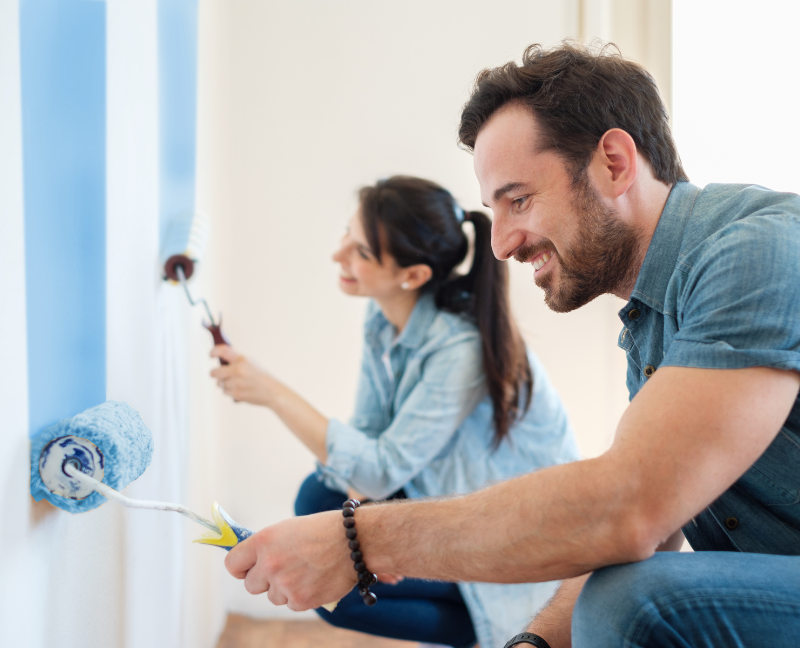
Cord concealers are available from reputable sellers like Amazon. Making your home appear effortlessly tidy and organized will depend greatly on if you can hide unsightly cords and wires from the TV or light fixtures.
Your garage's rusty wooden ladder might become your newest favorite decorative item. Use one to keep extra towels or throw blankets after cleaning it up with some sandpaper and possibly a coat of paint.
Purchasing used (pre-loved) furniture and home accessories is a terrific method to save money on items that would otherwise be quite expensive. You never know what secret treasures you'll find in a flea market or thrift shop.
You can give an old-end table a brand-new look with a little paint and creativity. Think about adding gold paint to the edge of a plain black piece.
Plates may make for some very stylish wall décor whether you never use the china from your wedding or the set you scored from an H&M sale. Install the customized plates on an empty wall for a quick update.
Want to add a beach vibe to your room? Then using a glue gun and jute rope, re-decorate an old vase or dish for a rustic touch.
The kitchen is one of the most utilized rooms in the house, so painting the cabinets will give it an instant facelift.
Looking for ways to decorate a home on a budget? Well, your wish is our command!
One of the cost-free decorating concepts simply needs creativity, time, and muscles. By rearranging the furniture, you can give your space a fresh feel.
Re-design a bookcase either by repainting or using removable wallpaper.
A new mirror hung above the vanity or sink is the fastest way to update an outdated bathroom. Luckily, there are many reasonably-priced options you can choose from online.
After your next dinner party, save a few wine bottles and turn them into unique vases. With a little hot water and soap, the labels come right off, leaving behind a slim vase suitable for containing a few fragile stems.
You can find affordable woven baskets at almost any retailer, online and offline.
Woven baskets are only good at keeping your space clutter-free; it also gives a quick Bohemian touch to the room.
Eclectic designs are frequently the simplest to reproduce across the board for interior design. Why? Mixing, not matching, is the key to this aesthetic. It will be far more economical to search for furniture and décor because there is no need to acquire a certain side table or that precise shade of blue.
These are just some decorating tips on a budget that you can consider. If you have more techniques, feel free to share them in the comments below.
A home purchase is not the same as signing a lease. Often, you sign a one-year lease when you rent a place.
If you want to avoid losing money on your property when you purchase a home and obtain a mortgage, you should be ready to commit for at least five years at a time. It turns out that the five-year commitment to homeownership offers many emotional and psychological advantages in addition to financial advantages.
So before you look for just listed homes for sale, here are the top 5 benefits you should consider:
A home purchase is not a quick investment. It is expensive to stay in a property for a period that is less than five years; most people plan to stay in their homes for ten to twenty years, and it's usually because of the up-front purchasing, closing, and mortgage fees. When you purchase a home with that goal in mind, you're more inclined to make investments in your neighborhood and property. You'll make an effort to get along with your neighbors better, volunteer, and take an active role in resolving issues when they arise.
Humans are social organisms that require close-knit networks to survive. Civic engagement, which is inherently motivated when you own a property, is the best method to cultivate these networks.
You'll experience less stress as a homeowner as long as your mortgage is manageable given your current financial circumstances.
Here are some of the reasons why:
According to studies, kids of homeowners typically do 9% higher in Math and 7% better in reading than kids of non-homeowners. Experts attribute that to the stability that homeownership brings to these kids' lives. Children thrive on regularity, so when they know what to anticipate, connect with the same friends, and experience the same environment—like your neighborhood—they feel less stress, and when they feel less stress, they perform better in school.
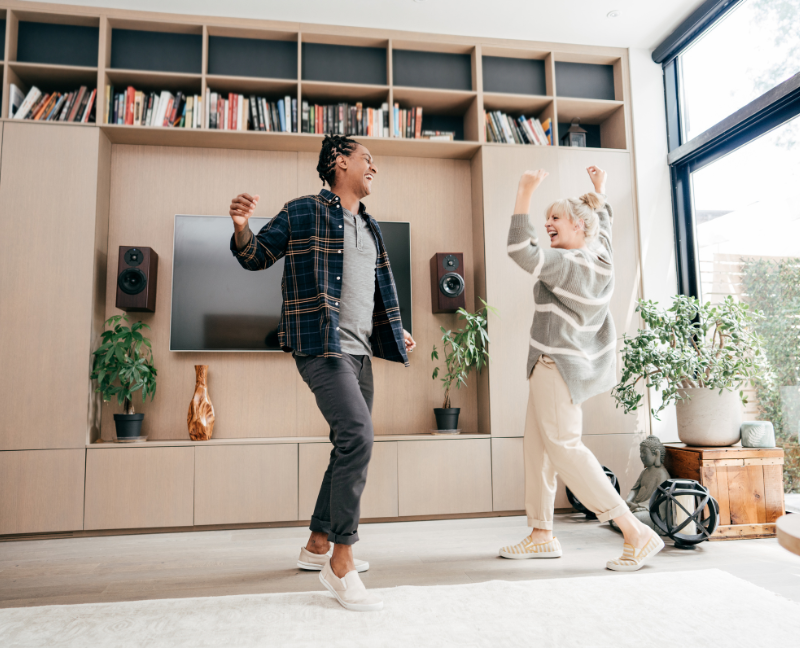
Who doesn't want their child or children to act more appropriately? According to studies, children of homeowners experience 1-3% fewer behavioral issues than children of renters. The stability that the young ones experience when their parents own their home as opposed to the potential unpredictability that comes with renting is what the researchers attribute their findings to. Researchers have found a link between parents' happiness and their kids' happiness, so if you're less stressed, your kids' stress levels will be too.
Renting generally means residing in someone else's house. As a result, not all elements of your surroundings are under your control. You have no control over, for instance, the chemicals your landlord puts on the apartment's landscaping or the materials they choose to use inside. Moreover, most landlords don't keep up with termites, rodents, or mold issues.
But, you have total authority over every choice made about your property when you own your own house. You can choose non-toxic building supplies and fertilizer, take care of bugs and mold, and other issues before they become a problem. You may create the kind of healthful environment you want in your house.
Although the financial advantages of homeownership are occasionally contested, they are widely established. You may not have thought about the emotional and psychological advantages of having a secure living situation, such as a fixed mortgage payment and the ability to completely manage your surroundings, that comes with home ownership.
These benefits might be more significant than any tax deductions or monetary gain you might experience.
If you're ready to begin your journey to owning your home or learn more about this process, our team at RE/MAX Advanced Realty is happy to help!
Give us a call at 317-298-0961 today!
Your pets might be prepared to begin an exciting new chapter in a new home, but what about you? Even while some animal family members might find it upsetting to relocate to a new location, there are ways to help them adjust with a little forethought.
For homeowners, coexisting peacefully with pets is of utmost importance. According to the American Pet Products Association's APPA National Pet Owners Survey, at least one pet is owned by 70% of all U.S. households or around 90.5 million people. This is an impressive number that affects several economic sectors, including residential real estate.
Today's house buyers are looking for properties that represent how much people adore their pets. Some homebuyers find it easy to select a pet-friendly real estate in Indiana by choosing a residence with hard flooring, a fenced yard, or a litter box.
Some pet-friendly home plans accommodate the canine members of the family.
Under-cabinet feeding stations, pet wash stations, and built-in crates, beds, or pet suites are some of the more well-liked custom elements of today.
Electronic pet doors and security cameras with remote access, which enable homeowners to keep tabs on their pets while they're away, are two more high-tech smart home additions that are in hot demand.

For pet owners, location matters.
Being close to an enormous nature trail away from crowded streets or an off-leash dog park is an added advantage, and living in a pet-friendly community is a need.
Also, although school districts are typically the main priority for parents of young children, some pet owners also search for homes close to their veterinarian, boarding house, and dog daycare.
Give your animals a tour of the new residence. Decide where the toys, bed, and water dish for your pets will go, then take them on a home tour to acquaint them with their new surroundings.
Make sure to check the house for potential safety risks before letting them explore and find new smells and favorite areas.
Start your cat off in a smaller area and give them time to explore; cats might feel better at ease acclimating to one room at a time.
When you follow this advice and maintain your pets' regular feeding and walking schedules, adjusting to a new house is simple. In the comfort of your new home, they should continue living their normal, happy lives with little to no interruption.
For more content like this, feel free to browse our website today.
A house can be restored to its original condition with recreations or original materials through a home renovation, which changes the purpose of an area. A home renovation repairs and updates an area without changing its purpose, and a home transformation returns to space to its original condition.
Compared to the time typically required to complete a standard home renovation, it may be a surprise to learn that our home transformations are usually completed in less than one month.
A typical home transformation will take between one and three weeks, beginning when the agreed-upon scope of work is finalized and ending when the house is ready to be placed on the market.
We know that some clients have full schedules, and because of this, we can take care of the entire process and alleviate some of their stress. With work, family, friends, errands, and occasionally children, not to mention a significant relocation coming up, it is our responsibility to remove the weight off of their shoulders and guarantee that the sale of their house is a tremendous possible success it has the potential to be.
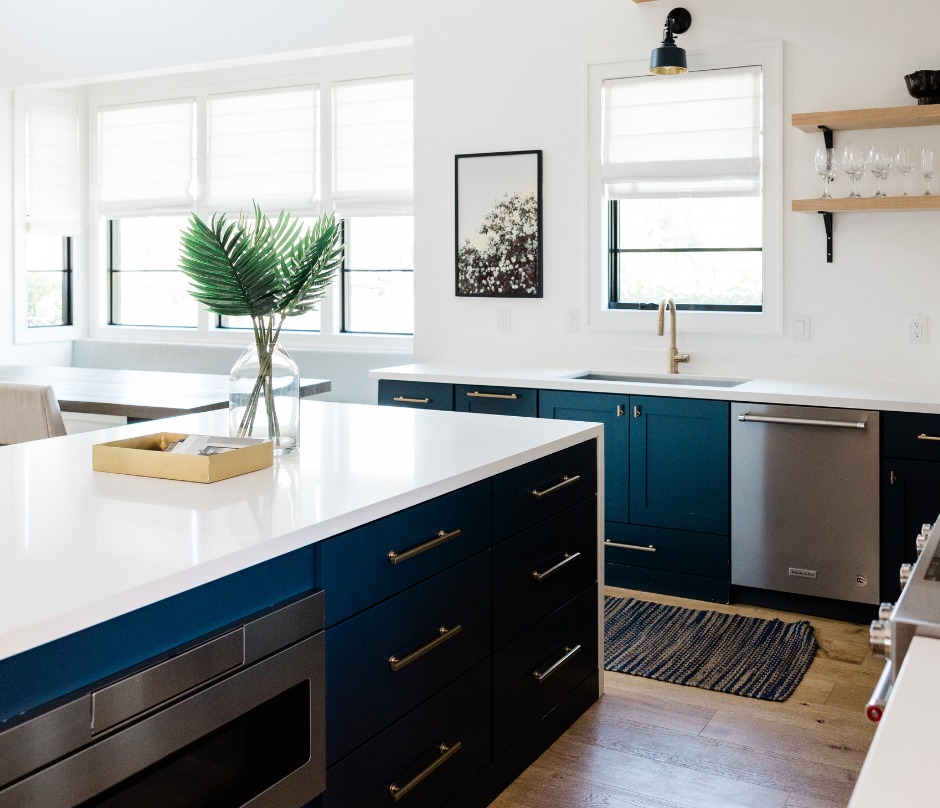
One of our most valuable trade secrets is that we control the entire production process from start to finish within our company. Still, we won't reveal all of them. Because we work with dependable vendors who collaborate with us consistently and because we have an in-house team of designers and photographers, the process runs smoothly from beginning to end.
If a home's bonus room has been decorated to demarcate the space clearly, prospective buyers may be more interested in purchasing a home with that room.
It may take some time to get commitments from contractors as there are currently a lot of home renovations taking place at the same time. Many people have concluded that the best time to improve their homes is because of Covid. This indicates that the typical time required to complete home renovations will increase, but not for our team. We work with preferred contractors who do excellent work and are always available for us, which enables us to manage the timing of the planned renovations in a manner that is quite efficient from the point of view of project management.
Compare this approach with the conventional method of doing home renovations. It was recently estimated that once a client contacts a home renovation company, it could take around three weeks to schedule the initial consultation, discuss plans, and acquire an estimate for the work. This estimate was based on a recent study that was conducted.
This estimate was derived from the results of a recent survey. After this step, the customer is added to the schedule of the business, which, depending on the volume of business, could be anywhere from a few weeks to several months in the future.
Fitting your belongings into a limited area can be difficult and irritating; however, leaving them outside can make your home feel and look cluttered.
Why not offer yourself peace of mind by decluttering? After all, studies have shown that a cluttered home can contribute to anxiety. Below are easy organization tips for small places.
Here are the three small space solutions you can try at home:
Kitchen counters can often be the messiest area of a home. Several quick small space storage solutions are:
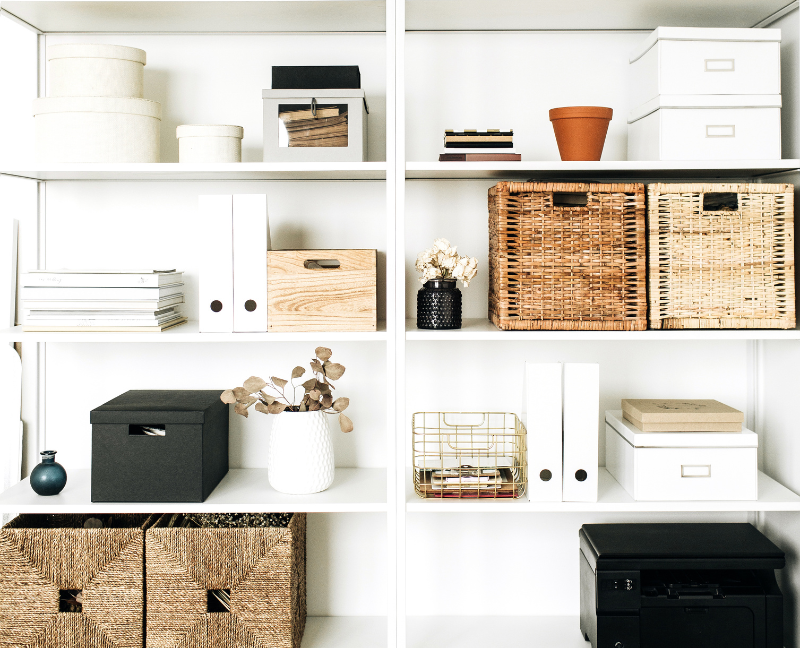
Unexpected places can offer storage opportunities. Unexpectedly, there is more space behind the door. A storage gold mine can be found under the bed. Space-saving solutions that are frequently used include:
If you have limited storage, minimizing often can be helpful. As you organize or find a home for your items, consider these basic letting-go methods:
These are just some small space storage hacks you can try at home. These solutions can help add space to your kitchen, bathroom, or living room. Find more content like this by visiting our website.
Coming home to a spotless home that literally sparkles is one of life's greatest pleasures.
With the help of spring cleaning advice from organizing and cleaning experts, it's easier to clean your home room by room or appliance by appliance because doing so can be intimidating, exhausting, and time-consuming.
Here are some spring cleaning chores you can do at home, whether you only have five minutes to freshen things up or you happen to have a full weekend to spare.
Clean windows make a home look better. Use water, ammonia, and white vinegar for professional-quality DIY cleaning. A large sponge and a professional squeegee apply and remove the solution from your windows.
The coils cool these appliances by circulating air. Dust on coils reduces efficiency, making your fridge or air conditioner work harder. Unplug the device and vacuum out the coils. You can use a refrigerator-coil brush that is available in the hardware store.
Clean ceiling-fan blades to eliminate winter dust. For summer, reverse your ceiling fan's motion from clockwise to counterclockwise. This cools the place by directing air downward.
You wouldn't believe how simple it is to clean a dryer vent. Remove the dryer's plug from the power source first. After that, use a vacuum or a special brush made for cleaning dryer vents to clean out the opening.
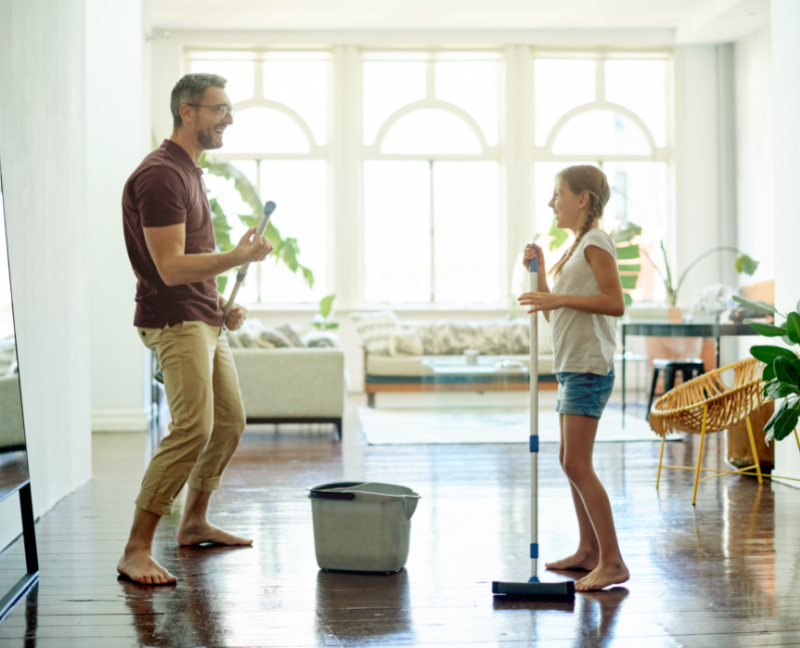
Even if you frequently vacuum your carpet, a deep cleaning every year will remove the trash, dust, and food debris from the carpet's deepest fibers. If you don't own one, you can rent one at a home improvement store or nearby supermarket chain.
The best time to inspect your roof for possible winter damage is springtime. Try looking from the roof with a pair of binoculars if you can't access it with a ladder.
Great if your wooden deck's finish is still good. Cleaning the deck may be enough to prepare it for summer. Clean and reseal the deck if the finish is worn. Tidy up and maintain composite decks according to the manufacturer's instructions.
Take those pressure washers, lawnmowers, and weed eaters out of storage, give them a test run, and ensure everything operates as it should. Tools can be fixed with lubricant or cleaning.
Combine a solution of 80% water and 20% ammonia with a half-teaspoon or a few sprays of gentle dishwashing detergent. Before soaking a soft cloth or sponge and wringing it out, completely blend the contents. While cleaning the wood furniture, don't let the solution dry out.
Wash or sweep the stairs and front porch. If your welcome mat is fraying or disintegrating, shake it or replace it. Your home will seem refreshed if you add one or two pots of annuals in vibrant colors.
Follow these spring cleaning activities and ideas to clean and give your home a beautiful and fresh inside and out. If you have more tips, feel free to share them in the comment box below.
New year, new outdoor look!
If you have an outdoor space in your home, you have the opportunity to turn it into an oasis! Whether it’s a large backyard or a tiny patio, your backyard can be a good spot to invite family and friends as the warm weather arrives.
Here are some tips on how to revamp your alfresco.
Reminiscing about a beach vacation? Create a tropical outdoor lounge on your patio or yard. You may buy lounge chairs, chaise lounges, hammocks, and outdoor sectionals online or make your own, like a lounge bed. This outdoor space idea requires a platform bed frame, futon mattress, and outdoor fabric. Pile outdoor pillows on top for comfort and style. Add side tables, candles, and a glass of wine to create an inclusive lounge.
Making a backyard cinema is easy. You can watch movies, TV shows, or whatever you're binging. The outdoor space design ideas need a projector, a taut white sheet, and your phone. If you don't own a projector, you can improvise things like a shoe box, cardboard, and a magnifying lens to construct one easily. Gather your favorite patio chairs or outdoor cushions, make popcorn, and watch a movie with crickets singing.
Why not make your outdoor space a bar since it's the shortest way home? You may buy a bar online, repurpose a table or desk, or create one with cinder blocks, concrete adhesive, and 1 x 6 planks. Bring your Bluetooth speaker, cocktail ingredients, and glasses home to recreate your favorite bar's atmosphere.

Although a barn or shed is a functional building, that doesn't imply it has to be unattractive. Give it a redesign by painting it a striking color, adding shutters, placing flower boxes, laying a stone path, or even hanging lights to brighten up that unused backyard space.
If you spend too much time camping, you'll notice the firepit, everyone's favorite activity. Build an outdoor fire pit in seven easy steps with materials from your local hardware store. You may acquire a prefab fire bowl that gives out the same warm, inviting campfire glow—research local burn regulations and rules to determine the best practices in your area.
Make a backyard or patio dining spot to spice up home nights. Add an outdoor rug, lighting, and a chandelier to change your nighttime dinners. Show your talent as a great cook or you can simply order food you can enjoy with your loved one.
Home is sometimes the best place to center. Create an outdoor meditation space to improve your therapeutic practice. Plant a lavender or jasmine garden, make a stepping stone walk to your meditation location, or add a standing tent or cabana with curtains to catch the mild wind.
These are just some cool outdoor space ideas you can consider to upgrade your patio and you can see more tips on the internet.
Which one is your DIY idea is your favorite?
Share your thoughts in the comment section below.
Looking for DIY ways to improve your home? If yes, then you’re in the right place!
Whether you are looking for simple projects or something more creative, this post will give you ideas on what to do.
You might be one of the many homeowners who have considered starting a home improvement project but ultimately decided against it due to a lack of time or motivation.
Don't feel bad. Half of the homeowners cite finding time to work on home improvement ideas as the most significant challenge. This may be one explanation for the number of unfinished home improvements that homeowners report.
But now that you have the interest, you can start to challenge yourself by doing these DIY ways to improve your home, and let your progress inspire you.
Since many of us are spending most of our time at home, now might be a good time to channel a little of that cabin fever into a project that might add value to your home or infuse it along with new energy.
The following is a list of DIY ways to improve your home:
No plumbing experience is required, and a gleaming new faucet can generate a lot of daily pleasure for only a little effort. All you need is a great attention to detail if you want to avoid flooding your kitchen just because you failed to turn off the water valve.
If you have no idea how to get started, there are lots of installing faucet tutorials online you can follow.
Lighting is one of the few elements that can completely transform the mood of space in such a short amount of time. A new atmosphere can be created for any event simply by replacing an old fixture with a new one or switching from an on-off switch to a dimmer one. If you are familiar with changing out light fixtures, then you should also be comfortable working with switches because they use the same kinds of cables.
This is a good idea for you and your family to work on in advance so you’re ready to spend more time outside when the weather gets nicer. You can make your fire pit in the backyard and throw a S'mores party to celebrate one's accomplishment.
You have various choices to upgrade your home into a smart one, some of which may be as simple as installing a light bulb or plugging in a gadget. It might also include:
Your kitchen can be updated without undergoing extensive remodeling. By replacing the door and drawer pulls, painting your cabinets, or removing the cabinet doors to create an open shelving impression, you may give your space an entirely new appearance. You may create open shelves from scratch if you have too much wall space and need more cabinets.
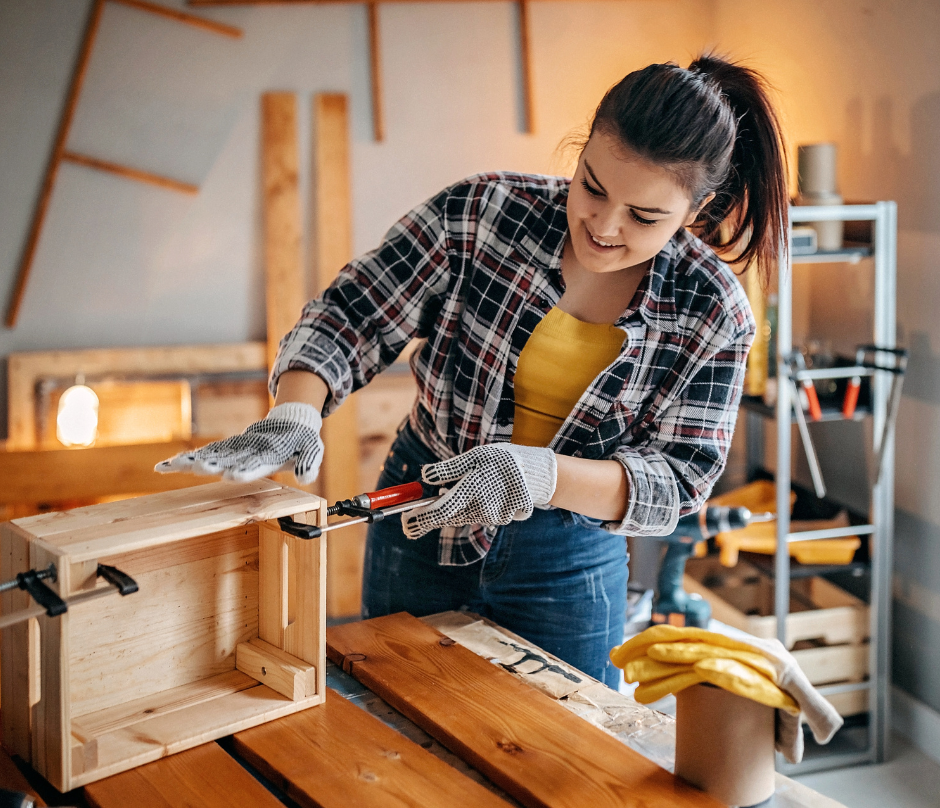
A barn door that slides on a rail can free up space, modify how furniture is arranged, and give your room a dramatic appearance by replacing a typical swinging door or closet slider. A few tools, an extra set of hands, and detailed step-by-step instructions that explain how to build and install the sliding barn door are needed.
You may not know the word, but you've likely seen this time-honored design feature in various homes. Because accuracy is necessary for this particular task, you will need the right equipment, including a measuring tape, a level, and a miter saw. In addition, patience. But if you can picture a three-dimensional element on your drywall, you're ready to continue to the next step.
If you have the skills to build a garden shed, you may discover various blueprints and how-to guides online that are customized to fit your preferences. And if you need more time to get up to that challenge, you can always add enhancements to the one you already have, or you can go out and purchase a standard model and make it your own. First, consider whether you need it for storage, additional workspace, or additional living space, and then go from there.
If you have yet to find your vocation and wound yourself at a desk job, this is the type of endeavor you can take on. You will become a hero or heroine in your home if you successfully warm your home from the ground up. This labor-intensive idea requires the confidence of an experienced tradesperson and some math abilities. This idea is perfect if you have already decided to replace a room's flooring and have the chance to do so while also including a heating element.
Feel free to share your DIY projects in the comment section below.
If you're planning to put your house up for sale this winter, don't lose hope. Many individuals are still looking for a house, even though purchasing a home may be off the top of everyone's priorities at this time of year.
Here's the question, what is the best way to sell a house this winter? Here are the top tips on selling your home, which will surely help you a lot. If you wish to sell your home quickly and easily this winter, follow these helpful tips first.
Even the real estate market can have the winter blues around this time of year. Home buyers and available homes experience a steep decline once the weather begins to cool and the holiday season begins. However, there are some occasions when it is necessary to sell something, even though there are better times to do it than the winter months. If you seem to be one of the unlucky people who is trying to sell your home around this time of year, you are going to need to take these additional steps to create your listing stand out from the other available options because there is a lot of competition.
Accept the fact that there will probably be some potential buyers coming through to visit the home during the winter months when you post the house for sale, but be aware that those buyers will be very motivated to make a purchase. Your home should be valued and priced fairly simply because fewer people have seen it.
If you live in a snowy area, ensure that all the walkways around your house and any outbuildings are salted and shoveled and that any porches, patios, or decks are clear of snow. If feasible, you should maintain the outdoor furniture set up and free of snow so potential buyers can imagine how they would utilize the space if they bought the home.
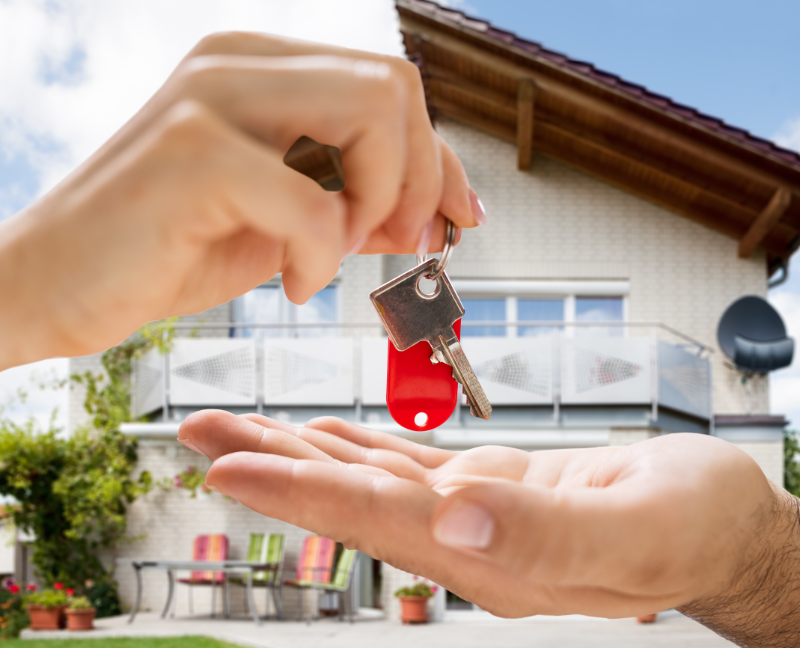
The presence of cloudy skies and bare trees can be made to appear less depressing by the addition of seasonal landscaping. Trim the edges of the garden beds, add a layer of new mulch, blow away any dead leaves, remove any dead vegetation, and then add seasonal splashes of color around the yard and the front door using decorations such as wreaths, holly, or evergreen topiaries.
Buyers can be enticed by all that beauty in the spring and summer when homes are surrounded by green grass and lush vegetation. These disadvantages are winter listings, so provide some images of your home at various seasons if you can. Choose images without a date stamp in the corner if you decide to. An image with an outdated date may indicate that your house has been on the market for a while, which raises a red flag for potential buyers.
Few things will put a performance on hold more quickly than a big appliance breaking down in the middle of the tour. Be sure to learn that the furnace needs to be repaired before the open house. Hire a professional to examine the house's furnace, fireplace, and other seasonal systems before you list them. Let your real estate agent know so she can bring it up during showings.
Winter days are shorter, so it's crucial to leave the lights on for potential buyers even when you're away. Add path lighting or spotlights and put your lighting on a timer to create a welcoming atmosphere for anyone stopping by or driving.
During the showings, the temperature ought to be in the range of 68 and 70 degrees Fahrenheit. If the fireplace is locked and someone is there to watch it, you can light a fire and serve clients hot beverages like coffee and hot chocolate.
If potential buyers of a house observe that it has a draft, they may interpret this as an indication that either something is wrong with the home's heating and cooling systems or that the existing owners have failed to keep up with necessary repairs. Alternatively, they may conclude that the current owners need to catch up with essential maintenance. Caulk and weatherstripping should be utilized where it is required to shut off drafts.
If you have already moved out of your home and it is currently lying vacant, consider having it set up by a professional who can create a warm and inviting atmosphere. If professional setup costs are prohibitive, consider leaving a few anchor pieces behind or borrowing extra furniture from friends. To bring warmth and happiness to each room, layer rugs, throws, pillows, and linens, including various winter plants.
Although your real estate agent will be responsible for most of the marketing efforts, running your social media campaign alongside their actions is always a good idea. Spread the word about your listing by posting it on social media platforms such as Facebook, Twitter, and Instagram. Look for local Facebook groups that center around local house buyers and sellers so you can publish your information in one of such groups.
You can do various things to boost the value of a home and make the selling process more manageable. The vast majority of these things are applicable whenever you choose to sell your house, regardless of the season. Even a handful of well-chosen changes can make all the difference when selling your home.
If you can afford to employ a handyman to fix all of your household problems, by all means, do so. But if you want to keep hold of your cash and practice self-sufficiency, you can purchase some clever items that address a million and one minor difficulties around the house.
These are just some of the tips you can consider when selling your house in winter. If you have more tips, feel free to drop them in the comments section below.

8313 W. 10th St
Indianapolis IN 46234
dennis@indyhomepros.com
317-316-8224